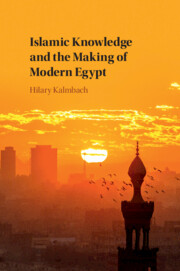Book contents
- Islamic Knowledge and the Making of Modern Egypt
- Islamic Knowledge and the Making of Modern Egypt
- Copyright page
- Dedication
- Contents
- Figures
- Acknowledgements
- Preface
- Notes on Transliteration and Use of Arabic
- Introduction: Hybridity, Islamic Knowledge, and ‘Being Modern’ in Egypt
- 1 Reform, Education, and Sociocultural Politics in Nineteenth-Century Egypt
- 2 Dar al-ʿUlum: Hybridity, Education, and Sociocultural Change, 1871–1900
- 3 Hybridity, Islamic Knowledge, and the Formation of Egyptian National Culture, 1882–1922
- 4 Fighting over the Future of Egyptian National Culture, 1923–1952
- Conclusion: Authority, Authenticity, and Revolution
- Book part
- Bibliography
- Index
1 - Reform, Education, and Sociocultural Politics in Nineteenth-Century Egypt
Published online by Cambridge University Press: 02 October 2020
- Islamic Knowledge and the Making of Modern Egypt
- Islamic Knowledge and the Making of Modern Egypt
- Copyright page
- Dedication
- Contents
- Figures
- Acknowledgements
- Preface
- Notes on Transliteration and Use of Arabic
- Introduction: Hybridity, Islamic Knowledge, and ‘Being Modern’ in Egypt
- 1 Reform, Education, and Sociocultural Politics in Nineteenth-Century Egypt
- 2 Dar al-ʿUlum: Hybridity, Education, and Sociocultural Change, 1871–1900
- 3 Hybridity, Islamic Knowledge, and the Formation of Egyptian National Culture, 1882–1922
- 4 Fighting over the Future of Egyptian National Culture, 1923–1952
- Conclusion: Authority, Authenticity, and Revolution
- Book part
- Bibliography
- Index
Summary
This chapter introduces Egyptian education and cultural politics between 1811 and 1900. First, it demonstrates how Egyptian reformers advanced projects of modernity by importing, translating, and applying European knowledge within Egypt, including through founding a new system of civil schools to run in parallel with long-standing religious schools, the elementary-level kuttab and higher-level madrasa. It explains how these school systems were misrepresented by European discourses that divided Egypt into two halves — a modern foreign and a traditional local. It uses the terms ocularcentric and audiocentric to deconstruct this dichotomy as applied to Egyptian education, and to show how Egyptian agency created projects of modernity that deliberately diverged from European models. Next, the chapter deconstructs the application of this dichotomy to the geographical and sociocultural landscapes through which Egyptians moved and claimed social status. This section focuses on the hybrid borderlands that developed around the schools and institutions associated with state-led projects of modernity. The chapter concludes by presenting 1868–75 as the key cultural turning point of late nineteenth-century Egypt, one that facilitated the colonisation of Egyptian minds a decade before the political transformations of 1876–82 finished the colonisation of their bodies.
Keywords
- Type
- Chapter
- Information
- Islamic Knowledge and the Making of Modern Egypt , pp. 49 - 88Publisher: Cambridge University PressPrint publication year: 2020

